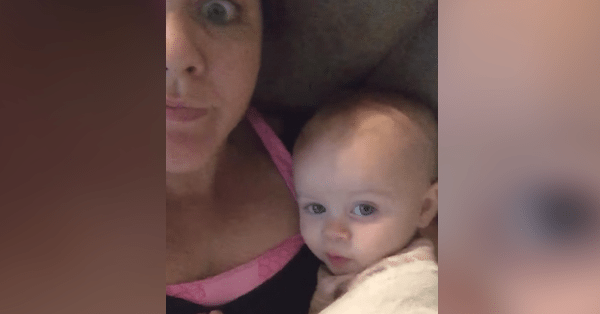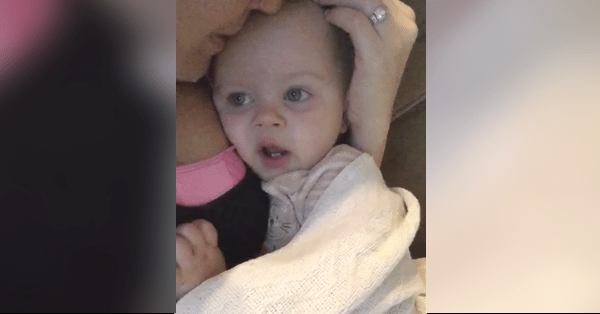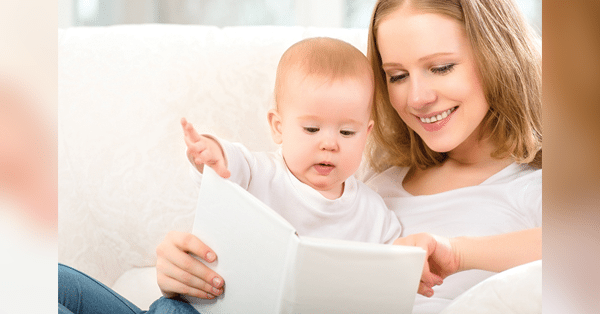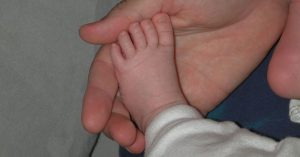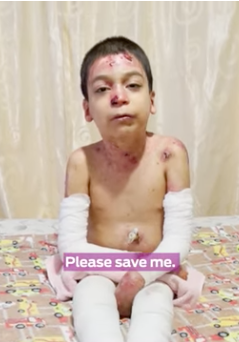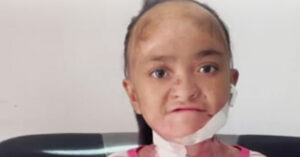Our children are God’s precious gifts to us. We love them unconditionally before they are even born, raise them up with care, and protect them from the dangers in this world. Children, especially babies, make us laugh and brighten up our days with their smiles and charm us with their innocence. Let’s face it, everyone falls for a baby’s adorable giggles and wide eyes, unless they have a heart of stone. Here is a story of one of those babies that is sure to melt your heart and make you go ‘Awww’.
Gemma Kate and her mom have caught the internet’s attention for all the right reasons. This little baby has learned to say ‘I love you’ in the most adorable way. Her mom sings ‘I love you’ to her baby girl and Gemma repeats it in the exact same way! Sure she hasn’t got all the sounds right yet since she’s only a toddler, but she’s definitely got the tune right.
It was a good thing her mom recorded their heartwarming exchange of love because everybody who sees this is sure to have their day made. No wonder the internet can’t stop gushing at this adorable video of the mother-daughter duo.
According to Babycenter, babies who are around Gemma’s age are capable of forming basic sounds of words, although they cannot speak yet. These sounds may often be intelligible, unless you are aware that they are replicating what you say as seen in the video. Toddlers often let out their first proper word around their first birthday, and they are usually simple or common objects, or easy sounding words. The website goes on to say, “Nouns usually come first, like ‘ball.’ The words may not always sound like adult words, but the words are used consistently for the same thing, for example ‘og’ for dog.”
While Gemma is yet to get her sounds right and tells her mom that she loves her perfectly, she has, undoubtedly, won over everyone with her singing skills. Her mother shows her affection for her little baby by cuddling with her and singing about her love. Gemma, in return, tries her best to return this love by repeating after her mom and singing her heart out. Gemma’s mom is surely experiencing the joys of being a parent. We hope baby Gemma keeps spreading the love! See this cute baby and her mother singing their ‘I love you’ song by watching the video.
If you think you too have a share-worthy moment with your baby, spread the joy like Gemma and let everyone know in the Facebook comments section!
Can Babies Really Talk?
Babies are very smart and we see a lot of videos on the internet of babies talking very early on in their lives! But when do babies normally start talking? Here is a baby talk timeline via parents.com:
Birth to 6 Months
What your baby is doing: Babies are born to listen. She’ll begin to associate sounds, linking the family dog to a bark, for example. Her first communication will be crying, but she’ll soon begin to use her tongue, lips, and palate to make gurgles, oohs, and aahs.
What your baby can understand: Babies as young as 4 weeks can distinguish between similar syllables like “ma” and “na.” As young as 2 months, they begin to associate certain sounds with certain lip movements.
4 to 6 Months
What your baby is doing: Sighs give way to babbling. You’ll hear back-of-the-tongue sounds, such as g and k, and lip sounds m, w, p, and b. He focuses on familiar words, his own name, or “mommy” and “daddy” as clues to help break up sentences.
What your baby can understand: At 4-1/2 months, he may recognize his name, but only as an important word, such as “Hi!” or “Bye!” It’s not until 6 months, at the earliest, that he’ll realize his name actually refers to himself.
7 to 12 Months
What your baby is doing: Her babbling will begin to sound more like words. She’ll intentionally repeat sounds (like “gaga”) over and over. At about 9 months, she’ll start to understand gestures, pointing and grunting to indicate her wants. At about 10 months, she’ll gain more control and begin combining sounds. The first word often appears around 12 months. Common first words may be greetings (“hi” or “bye-bye”). Or they might be very concrete: people (“ma, ma” or “da, da”), pets (“doggy” or “kitty”), or food (“cookie,” “juice,” or “milk”).
What your baby can understand: Your baby is slowly beginning to comprehend a few words, things like names and everyday objects such as “bottle” or “crib.” She keys in on intonation, realizing that a sharp tone often means “No!” or “Stop!”
13 to 18 Months
What your toddler is doing: As soon as your baby gets out that first word, he’ll try for more. Vocabulary builds slowly at first, just a few words a month. Kids seem to prefer nouns at first, then gradually add verbs and adjectives. He’ll experiment with one-word questions, like “Cookie?” for “May I have a cookie?” and delight in saying “No!”
What your toddler can understand: He should understand the first rudiments of grammar, such as the difference between “The dog bit the man.” and “The man bit the dog.” He should grasp simple instructions and understand many more words than he can say.
19-24 Months
What your toddler is doing: Though linguists aren’t sure why, toddlers at about 19 to 20 months have a “language explosion.” After months of slow progress, they suddenly start to learn words at a ferocious rate, as many as nine a day.
This explosion of words leads to the exhausting “Wassat?” stage. By the end of the second year, your toddler will be stringing two, or even four, words together in sentences. This is also an age of cute mistakes, as kids overextend and “under-extend” concepts. For instance, your child may learn that the round toy is a “ball,” figure all round things must be balls and point to the full moon, and chirp, “Ball!”
What your toddler can understand: Your baby will slowly begin to understand the idea of verbs. Fully aware that you are her key to language, she will watch and listen to you, absorbing everything you say and do.
25 to 36 Months
What your baby is doing: In the third year, your child really begins to put it all together. He’s refining what he’s learned so far. He adds “When? Why? Where?” to “Wassat?” He begins to add complex ideas, learning that “no” can mean “not” or “don’t” or “it’s all gone.” Late in the year, he may begin to use more abstract verbs like “think” and “know.” As his memory grows, he starts to tell short stories. As he gains control of the tip of his tongue while speaking, he begins to manage sounds like ph, th, and r.
What your baby can understand: He will begin to understand tense, plurals, and suffixes such as “ing” and “ly.” Late in this third year, your child may be able to tell short stories.
Things you can do to help: Rhyming games help build awareness of language sounds. If he makes a mistake, repeat the sentence back correctly instead of drawing attention to the error. For instance, if he says, “I goed playground.” You can say back, “You went to the playground? Great!” Add storybooks with more of a narrative. Kids need more assistance than we do for conversation. Take a look at his preschool class list, and start making stuff up. Was Mary in school today? Add something silly, like “Was she wearing that hat with the fruit on it again?” See what happens — you may find out what’s going on.
What to watch: Kids’ thoughts may go beyond their ability to form words.If stuttering, or some other problem, like a lisp, concerns you, consult your pediatrician.
[Source/parents.com]
Did you think this little baby is adorable? Share this video with your friends to brighten their day!
